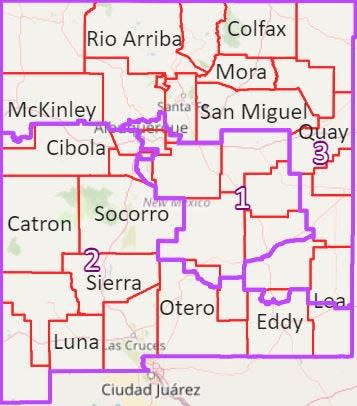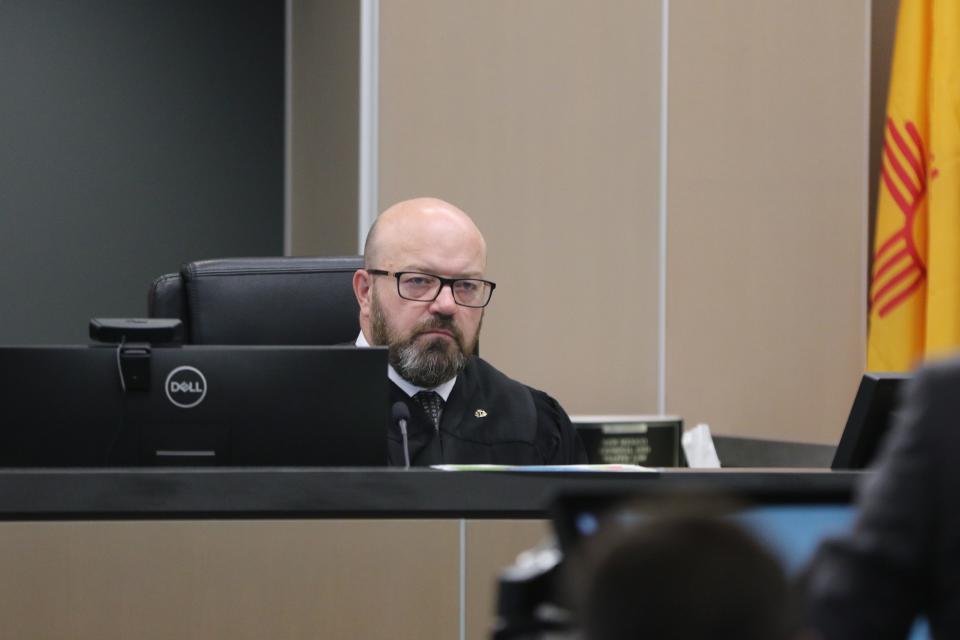Democrats admit to diluting GOP votes in congressional map redraw, but argue its allowed
Arguments made before the New Mexico Supreme Court Monday hinged on the narrow results of the 2022 election and ongoing political competition in New Mexico’s Second Congressional District, as Republicans continued their challenge of New Mexico’s redrawn congressional maps.
The GOP questioned the legality of the congressional maps redrawn in 2021 in response to population changes found in the 2020 Census, arguing the new maps gave Democrats an unfair advantage.
Oral arguments were made to the state’s Supreme Court in the GOP’s appeal of a district court decision in the party’s lawsuit against the maps, upholding the redistricting process as constitutional.

More: Appeal of New Mexico gerrymandering verdict going before state Supreme Court
The five New Mexico Supreme Court justices questioned lawyers on both sides, evaluating the argument by the plaintiffs that the district court was wrong in issuing its ruling.
Following the hearing, the Supreme Court will deliberate and likely later issue its verdict.
GOP argues Democrats 'cracked' the oilfield when redrawing maps
New Mexico’s minority party filed a lawsuit against Democrat lawmakers and state officials seeking to have the new map thrown out.
More: Republicans plan to appeal verdict to uphold maps in New Mexico gerrymandering lawsuit
Attorney for the plaintiffs, Carter Harrison, said during the hearing that the district court erred in finding the new map did not violate the state’s constitution.
He said evidence presented during the previous three-day bench trial in Fifth Judicial District Court in Lovington proved Democrats acted illegally when redrawing the map.
The boundaries were shifted, via a bill backed by Democrat lawmakers during a special session, to move portions of Republican-leaning Lea and Eddy counties out of the Second Congressional District and into the Third District.
More: New Mexico gerrymandering trial concludes, judge has a week to rule on congressional maps
Part of Democrat-leaning Bernalillo County was moved into the Second District.
The GOP argued in its lawsuit that this amounted to “cracking and stacking” by splitting up the Second District’s conservative majority while moving more Democrat voters into the district to dilute Republican influence.
That came to a head in the 2022 election, that saw Democrat challenger Gabe Vasquez defeat Republican incumbent Yvette Herrell for Second District seat in the U.S. House of Representatives by a narrow 1,300 vote margin.
This flipped the seat in what was traditional Republican stronghold in southern New Mexico, including the largely conservative southeast corner of the state defined economically by the oil and gas industry.
More: GOP says Democrats diluted oilfield votes in first day of New Mexico gerrymandering trial
Justices debate intent versus effect of New Mexico redistricting
Harrison said this was both the “intent and effect” of the redistricting process.
“From the very beginning, our case proceeded under belief that the co-opting of the legislative process of the majority party to further its own electoral goals, subverting and subordinating legitimate non-partisan redistricting factors to the politically ideal spreading of the state's partisan performance numbers if carried out successfully is an egregious partisan gerrymander,” he said.
Chief Justice Shannon Bacon said the case must separate the intent from the effect of the process in question.
More: GOP, Democrats clash over election data in final day of New Mexico gerrymandering trial
She said the case against the map must show the Democratic Party was “entrenched” in New Mexico, meaning it was likely impossible for Republicans to win the seat, not just that GOP votes were diluted.
“That’s my concern for this case,” Bacon said during the hearing. “We focus on the word egregious. You don’t want the court to be the deciding factor in the political process.”
Concerns for the case were also raised by other justices that while Democrats may have sought an advantage, the effect was unclear due to the closeness of the 2022 election and ahead of the 2024 election for the Second District.
More: New Mexico gerrymandering trial starts this week. Here's what to know about the case.
Justice Brianna Zamora pointed to a wider margin between Democrat incumbent Xochitl Torres Small and Herrell in the 2020 election when Herrell won the seat than the 2022 election, indicating the new maps actually made the district more competitive.
“That’s what I’m having trouble with, in the case, the results of prior elections,” Zamora said.
GOP votes diluted. But did it force a win for Democrats?
During a three-day bench trial in Lovington District Court, Republican plaintiffs presented testimony they said showed Democrats purposefully shifted voters to predetermine a favorable outcome in the election to an extent that was egregious and thus in violation of the New Mexico Constitution.
More: 'Gerrymandering' lawsuit against New Mexico Democrats delayed ahead of trial
Ninth Judicial District Judge Fred Van Soelen, who was assigned the case after all the judges in the Fifth District either recused themselves or were unavailable, found Oct. 6 that while some gerrymandering did occur during the redistricting process it was at a level permissible since the Second District remained competitive.

Bacon said the GOP was asking the Supreme Court to lower the standard for finding a map was unconstitutional, despite Van Soelen’s ruling, and argued that any legal redistricting process would be political and likely favor the majority party.
“Every change is going to create dilution,” she said. “Politics are allowed to be part of this process by definition. I know your clients, being in the minority party, want something that is politically neutral, but that’s not the process that we have.”
Attorney for the Democrats Sarah Sanchez said that while the party did seek to dilute GOP votes, it did not actually achieve unconstitutional gerrymandering, a fact she said was proven by the outcome of the 2022 election and the continued potential for either party to win the seat.
“Substantial dilution is the means by which the redrawer achieves entrenchment in an egregious partisan gerrymander,” Sanchez said. “What we have to look at is what is the outcome of that substantial dilution. A highly competitive district that either party can win is the antithesis of entrenchment.”
Adrian Hedden can be reached at 575-628-5516, achedden@currentargus.com or @AdrianHedden on X, formerly known as Twitter.
This article originally appeared on Carlsbad Current-Argus: GOP and Democrats clash in oral arguments of gerrymandering appeal

